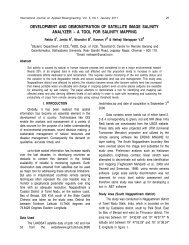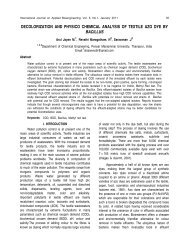Download Full Paper - Sathyabama University
Download Full Paper - Sathyabama University
Download Full Paper - Sathyabama University
Create successful ePaper yourself
Turn your PDF publications into a flip-book with our unique Google optimized e-Paper software.
18 National Journal on Advances in Building Sciences and Mechanics, Vol. 1, No.2, October 2010<br />
Whereas in Kalina cycle the condensation at high<br />
temperature and low pressure is achieved by the<br />
incorporation of separator. With the utilization of binary<br />
mixture the following improvements can be achieved.<br />
(i) Reduction in fuel proportion with the gains in<br />
efficiency.<br />
(ii) For condensation low pressure is sufficient.<br />
(iii) For spinning the turbine high pressure is<br />
obtained.<br />
Why Kalina Cycle?<br />
In Rankine cycle more than half of the heat<br />
transfer occurs during the boiling process<br />
which is considered as constant temperature<br />
boiling process.<br />
In ORC utilizing isopentene as working fluid,<br />
isopentene boils at a constant temperature<br />
under a given pressure.<br />
In Organic Rankine cycle the theoretical<br />
efficiency and cost/production ratio are less.<br />
Present work calculates the efficiency of the<br />
existing real time cycle (Hawaii Plant) using MATLAB.<br />
The practical efficiency calculation was compared with<br />
the simulated value and happened to find a percentage<br />
error of less than 5%. In addition to which a high<br />
temperature plant was considered and the same<br />
practical and simulated efficiencies were compared.<br />
In addition, a new model is proposed and the<br />
efficiency calculation were made.<br />
II. CORRELATIONS FOR CALCULATING<br />
THEMODYNAMIC PROPERTIES<br />
For determining the performance of the power<br />
cycle correlations the thermodynamic properties were<br />
calculated. In this work the correlations proposed by<br />
Ziegler and Trepp, Patek and Klomfar and Soleimani<br />
were utilised and developed in MATLAB. The Gibbs<br />
free energy for both liquid and vapor phases were used<br />
for determining enthalpy, entropy and volume. The<br />
correlations were coded in MATLAB and executed.<br />
Hawaii Plant<br />
The largest “waste heat” resource available in<br />
Hawaii for kalina cycle application is the heat stores in<br />
the tropical region surrounding the state.<br />
The 10000 kW hawaii plant has inlet temperature<br />
of 26C.<br />
The process uses a binary working fluid of<br />
ammonia and water with distillation / condensation<br />
subsystem which enables different working fluid<br />
mixtures at different stages of the cycle with heat<br />
recuperative stages for increased efficiency.<br />
The DCSS provides essential to the existence in<br />
establishing the high ammonia-water concentration for<br />
the heat acquisition stage and a low ammonia-water<br />
concentration at the condensation stage.<br />
Fig. 1. Hawaii Kalina Cycle Power Plant<br />
Table 1 Plant Performance Summary<br />
Plant Simulation<br />
Heat In 513897.50 kW 513897.50 kW<br />
Heat Rejected 503729.64kW 503729.64kW<br />
Power Turbine 10526.32 kW 10048.34 kW<br />
Gross Generator<br />
Power<br />
10105.26 kW 9646.40 kW<br />
Power Pumps 382.25 kW 427.96 kW<br />
Net Output 10144.07 kW 10476.3 kW<br />
Thermal<br />
Efficiency<br />
1.97% 2.02%<br />
Plant Efficiency 1.54% 1.46%









